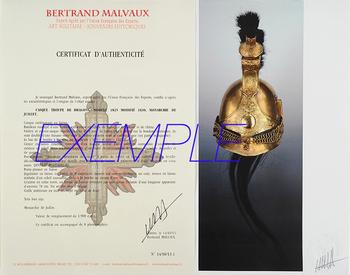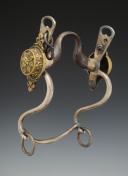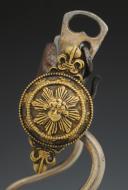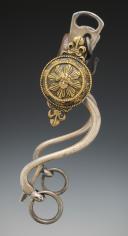
OFFICER'S BRIDLE BIT OF THE KING'S BODYGUARD HOUSEHOLD CAVALRY, model 1814, Restoration period. 29828.
Sold out
OFFICER'S BRIDLE BIT OF THE KING'S GUARDS OF THE ROYAL MILITARY HOUSEHOLD, model 1814, Restoration period. 29828
S-shaped branches of the so-called "Condé" model. Silver-plated brass bosses depicting the Sun's face on a radiant background framed by a double high relief beaded molding with a scattering of fleur-de-lis. A fleur-de-lis is depicted in the upper and lower parts of the boss. Boss height 8 cm, width 4.3 cm, thickness 2.5 cm. Mouth passage silver-plated on the sides.
France.
Restoration period.
Very good condition.
PROVENANCE:
Former collection of Hippolyte Marie-Joseph Boivin (Guermantes, September 8, 1857, Bouvresse June 19, 1912).
This scholar from the late 19th century assembled a collection of extremely important patriotic faience, which was exhibited several times in French museums.
With a collector's temperament, Hippolyte Boivin gathered faience from Rouen, Marseille, Strasbourg, Delft, Nevers, enamel dial watches from the First Empire, ancient limbs, Norman and Picard cabinets and clocks, variously aged chests and clocks, tapestries, rattles from all over France and even abroad.
His grandson recounts that H. Boivin and his wife traveled from village to village, buying any objects that seemed of interest to them. These acquisitions enriched his personal collections and those of the Beauvais museum, where he was the curator from 1889 to 1912. In his collecting pursuits, he also developed a passion for military mementos, primarily headgear, brasswork, bridle bits, and various historical memorabilia.
He had a gallery built in his garden to house his military collections, which would later be displayed in the "Boivin hall" of the Dejean barracks in Amiens, destroyed during the Second World War. Hippolyte Boivin showed his preference for patriotic faience by reproducing through drawing and watercolor the pieces he had collected. Two factors may explain this attraction: firstly, his family's exile from Champagne during the German invasion of 1870 may have instilled in him a taste for patriotic and military objects; secondly, his maternal grandfather's occupation running a stoneware pottery factory in La Chapelle-aux-Pots may have influenced his love for ceramics.
The items in this enlightened collector's collection were all acquired based on opportunities encountered "in the field," further ensuring their homogeneity given the collecting period: from the fall of Napoleon III until the eve of the Great War.
S-shaped branches of the so-called "Condé" model. Silver-plated brass bosses depicting the Sun's face on a radiant background framed by a double high relief beaded molding with a scattering of fleur-de-lis. A fleur-de-lis is depicted in the upper and lower parts of the boss. Boss height 8 cm, width 4.3 cm, thickness 2.5 cm. Mouth passage silver-plated on the sides.
France.
Restoration period.
Very good condition.
PROVENANCE:
Former collection of Hippolyte Marie-Joseph Boivin (Guermantes, September 8, 1857, Bouvresse June 19, 1912).
This scholar from the late 19th century assembled a collection of extremely important patriotic faience, which was exhibited several times in French museums.
With a collector's temperament, Hippolyte Boivin gathered faience from Rouen, Marseille, Strasbourg, Delft, Nevers, enamel dial watches from the First Empire, ancient limbs, Norman and Picard cabinets and clocks, variously aged chests and clocks, tapestries, rattles from all over France and even abroad.
His grandson recounts that H. Boivin and his wife traveled from village to village, buying any objects that seemed of interest to them. These acquisitions enriched his personal collections and those of the Beauvais museum, where he was the curator from 1889 to 1912. In his collecting pursuits, he also developed a passion for military mementos, primarily headgear, brasswork, bridle bits, and various historical memorabilia.
He had a gallery built in his garden to house his military collections, which would later be displayed in the "Boivin hall" of the Dejean barracks in Amiens, destroyed during the Second World War. Hippolyte Boivin showed his preference for patriotic faience by reproducing through drawing and watercolor the pieces he had collected. Two factors may explain this attraction: firstly, his family's exile from Champagne during the German invasion of 1870 may have instilled in him a taste for patriotic and military objects; secondly, his maternal grandfather's occupation running a stoneware pottery factory in La Chapelle-aux-Pots may have influenced his love for ceramics.
The items in this enlightened collector's collection were all acquired based on opportunities encountered "in the field," further ensuring their homogeneity given the collecting period: from the fall of Napoleon III until the eve of the Great War.
Reference :
29828

Next update Friday, april 25th at 13:30 PM
FOR ALL PURCHASES, PAYMENT IN MULTIPLE CHECKS POSSIBLE
bertrand.malvaux@wanadoo.fr 06 07 75 74 63
An authenticity certificate of the item including the description published on the site, the period, the sale price, accompanied by one or more color photographs is automatically provided for any item priced over 130 euros. Below this price, each certificate is charged 5 euros.
Only items sold by me are subject to an authenticity certificate, I do not provide any expert reports for items sold by third parties (colleagues or collectors).


